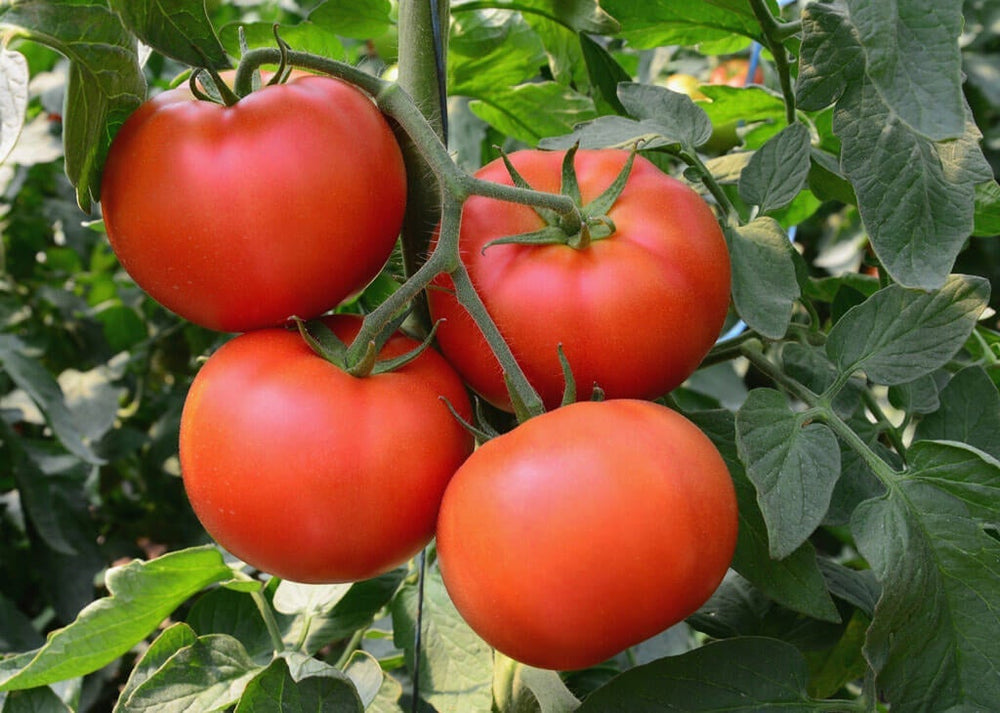Tasty and terrific, tomatoes offer garden magic at its best, transforming yellow blossoms into juicy fruits. But perhaps the most amazing thing about tomatoes is their adaptability. These yummy gems grow and thrive in a host of ways, from classic in-ground beds to quirky upside-down planters. Let us help you discover which of these ways to grow tomatoes is best for you.
1. In the ground
This method is perhaps the most common way to grow tomatoes.
Advantages
- You can plant almost any variety.
- Plants require less water than those in containers.
- An in-ground garden can produce exceptionally heavy yields.
Disadvantages
- It requires yard space that gets a lot of sunshine.
- Wildlife pests like deer, gophers, birds, and squirrels seem to prefer this type of garden.
- If soil-borne diseases occur, it's tougher to sterilize or replace the soil.
2. In a raised bed
Raised beds used to be reserved for folks with a desire to do some DIY. These days, though, you can buy affordable kits that a child could assemble.
Advantages
- They provide excellent drainage.
- It's easy to customize, amend, and (if necessary) replace soil.
- Soil doesn't become compacted from being stepped on, allowing more aeration for root growth.
- Raised beds, especially higher ones, require less bending and stooping than in-ground beds.
Disadvantages:
- Raised beds require an upfront investment for materials.
- Garden layout may be less efficient, as you need to leave space for walking between boxes.


3. In a container
Containers are an extremely versatile option for growing tomatoes.
Advantages
- You can grow virtually anywhere there's sun, including on a patio, deck, or rooftop.
- Pots are mobile, letting you shift tomatoes in or out of cold, hail or whatever else Mother Nature sends your way.
- No need to wait for soil to warm in spring, so you can plant earlier.
– Harvesting is often easier, as pots can be placed near the house and high off the ground.
Disadvantages
- You must be sure to choose the right size pot for the variety you're planting.
- Container gardens dry out more quickly than in-ground ones. During peak growth, expect to water daily.
- In windy areas or on exposed decks, lightweight pots may need support to stay upright.

6 Ways to Grow Tomatoes in Containers
The remaining six ways to grow tomatoes all refer to particular types of containers, so the advantages and disadvantages noted above still apply.
4. In a bucket
This is perhaps the most inexpensive, readily available type of container.
Advantages
- You can up-cycle buckets from your home. Bentley Christie of Red Worm Composting uses kitty litter buckets to grow tomatoes in soil taken from his worm bins.
- All kinds of buckets can host tomatoes: galvanized, 5-gallon, food grade, or whatever you can get your hands on.
- Most buckets remain moveable once planted, although they may be top-heavy.
Disadvantages
- You have to add drainage holes.Metal buckets can rust over time, leaving marks on a patio or deck.
- Many buckets aren't large enough to grow indeterminate tomatoes.
- Dark colored plastic containers can cause roots to overheat, stunting (or even killing) plants.
- Neighbors might complain about less attractive buckets, especially if you're growing them in highly visible areas.

5. In a whiskey barrel
Handsome whiskey barrels are an all-time favorite container type.
Advantages
- Large size provides ample root space to grow larger tomatoes.
- Barrels are decorative and complement many settings.
Disadvantages
- It's heavy and usually can't be moved once filled and planted.
- Adding drainage holes requires a little muscle to push through the wood.
- Barrels eventually rot.

6. In a grow bag
Fabric grow bags are a relative newcomer to the container market.
Advantages
- Grow bags allow increased airflow to roots.
- You can make your own. Debbie Glade, of Smart Poodle Publishing, grows a few dozen tomatoes in Miami, Florida, and used to make her grow bags out of landscape fabric (shown above).
- Most grow bags are reusable. Debbie washes hers twice after the growing season, bleaching them to help kill disease organisms.
- They don't need drainage holes.
Disadvantages
- Most grow bags aren't mobile once planted.
- Increased airflow means more water is lost, so bags require even more watering than pots do.

7. In a window box
Bring the harvest to you by planting window boxes with tomatoes. Mark Ridsdill Smith of Vertical Veg suggests using a box that holds at least 1.5 gallons of soil, drilling small holes along the sides for drainage, and using a string trellis tied to anchors set into the wall above the window.
Advantages
- Harvesting is a snap—just open the window and pick.
- Watering and plant care are convenient.
- The higher above ground level you grow tomatoes, the fewer pests tend to find them.
Disadvantages
- You'll want to stick with cherry-type tomatoes (either dwarf bush or vines), as the fruit is light and small.
- Window boxes require proper attachment, which may require some DIY talent (or a handyman).
- Strong summer winds can dislodge plants and/or boxes if they aren't anchored well.

8. In a hanging basket
Hanging baskets are common fare on porches, but how about dangling them outside a window for a vertical garden? (See Ridsdill Smith's tips on soil volume and trellising in the Window Box entry above.)
Advantages
- No stooping while tending and harvesting.
- You can either hang the basket or display it on a pedestal in the garden for an eye-catching focal point.Cascading tomatoes can be as colorful as flowers.
Disadvantages
- Baskets need to be watered more frequently than tomatoes in beds or larger containers.
- Hanging hardware must be strong enough to support a basket filled with wet (heavy) soil.
- You must choose tomato varieties carefully. Cascading cherry tomatoes work best.

9. In an upside-down planter
You can buy manufactured containers, or make your own using pots or buckets.
Advantages
- The planter allows for excellent airflow.
- Plants don't need staking.
- Fewer weeds take root in containers.
- Upside-down plants don't take up valuable yard space.
- You can stand while tending plants.
- Birds are less likely to peck at fruit because it's harder for them to perch.
Disadvantages
- Upside-down tomatoes need frequent watering, but it can be tricky to determine just how much and how often.
- Any water not absorbed by the soil will drip onto plant leaves and fruits, which can invite disease.
- Many gardeners experience low yields.
- You must install some kind of hardware to hang plants.
Article written by Julie Martens Forney.





 Herbs
Herbs
 Vegetables
Vegetables
 Fruit
Fruit
 Flowers
Flowers
 Succulents
Succulents


